Have you ever wondered about the smallest volcano in the Philippines? What makes it unique and why is it a cause for concern? Join us as we delve into the intriguing world of Taal Volcano, a natural wonder that holds both geological significance and cultural importance.
Taal Volcano, also known as Bulkang Taal, is a small volcano located in the Philippines. It stands as a captivating and dynamic force in the province of Batangas, just 50 kilometers south of Manila. But don’t let its size fool you, as Taal Volcano is recognized as the second most active volcano in the country, with a history of 38 recorded eruptions.
The real marvel lies in the geography of Taal Volcano. Nestled within the picturesque Taal Lake, the volcano consists of overlapping cones and craters on Volcano Island, which is situated at the center of the volcano’s caldera. In fact, the Main Crater on Volcano Island is renowned for its breathtaking crater lake, the largest lake on an island in a lake on an island in the world. This unique landscape, combined with Taal Volcano’s rich history, makes it a fascinating subject worth exploring.
Key Takeaways:
- Taal Volcano is the smallest volcano in the Philippines, yet it is the country’s second most active volcano.
- The volcano is located in the province of Batangas, just south of Manila.
- Taal Volcano’s geography is characterized by its overlapping cones and craters on Volcano Island.
- The Main Crater on Volcano Island is home to the largest lake on an island in a lake on an island in the world.
- With a rich history and unique landscape, Taal Volcano is a captivating natural wonder that requires careful monitoring and preparedness to ensure the safety of nearby communities.
Geographical Location and Features of Taal Volcano
Taal Volcano, located in the province of Batangas, Philippines, is situated at coordinates 14°0′36″N 120°59′51″E. It is nestled within Taal Lake, an integral part of the volcano’s caldera. Taal Lake and Volcano can be found in the municipalities of Talisay and San Nicolas, Batangas. The volcano is part of the Luzon Volcanic Arc, a volcanic chain running along the western edge of Luzon Island.
Taal Volcano’s geographical features include a series of overlapping cones and craters on Volcano Island. In total, there are 47 identified cones on the island. The main crater, known as the Main Crater, stands out with its large crater lake. This crater lake is considered the largest lake on an island in a lake on an island in the world. It is a unique and stunning natural feature.
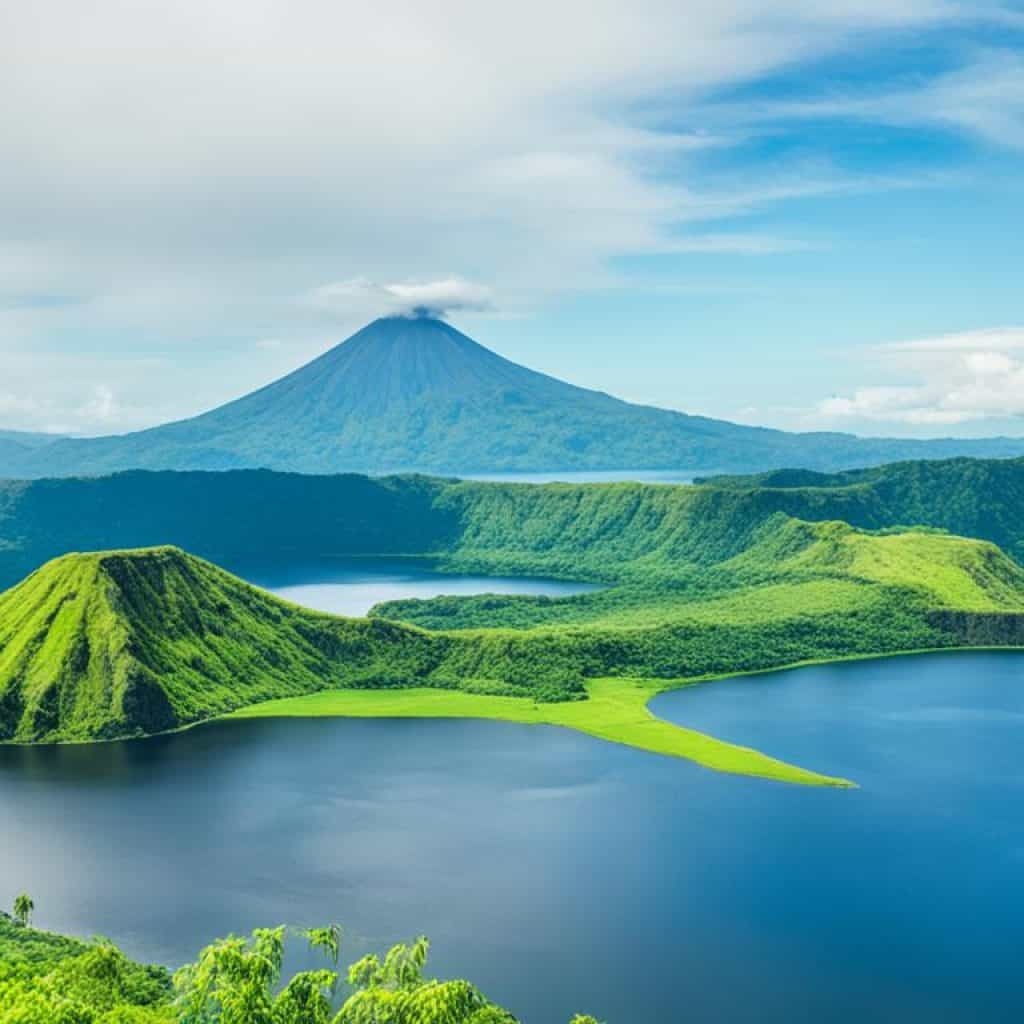
Taal Volcano’s geographical location and diverse features make it an intriguing destination for nature enthusiasts and adventurers alike. The stunning landscape and the presence of the crater lake contribute to its allure and showcase the power and beauty of our natural world.
Historical Eruptions and Impact of Taal Volcano
Taal Volcano has a history of violent eruptions that have caused significant damage and loss of life. Between 1572 and 1977, there were 54 recorded eruptions from Taal. The first eruption occurred in 1572, shortly after the town of Taal was founded on the shores of the lake. Since then, numerous eruptions have taken place, with the most devastating eruption happening in 1754. Lasting for approximately 200 days, this eruption led to the relocation of several towns due to the destruction caused by ash, mud, and volcanic debris.
The total death toll from the eruptions of Taal Volcano is estimated to be around 6,000. The impact of these eruptions on the surrounding communities has been catastrophic, with lives lost and livelihoods destroyed. The destructive power of Taal serves as a stark reminder of the need for proactive measures to prevent and mitigate the impact of natural disasters.
Recognizing the ongoing threat posed by Taal Volcano, it has been designated as a Decade Volcano. This initiative focuses on promoting research, preparedness, and early warning systems to reduce the risk and impact of volcanic eruptions. By prioritizing the study of Taal and other Decade Volcanoes, we can work towards preemptive measures that safeguard lives and communities from the devastating consequences of natural disasters.
| Historical Eruptions | Death Toll |
|---|---|
| 1572 | Unknown |
| 1754 | Approximately 6,000 |
| … | … |
Significance of Taal Volcano’s Etymology
The name “Taal” holds significant meaning in the Batangueño dialect and Tagalog, the language spoken in the Philippines. In Tagalog, “Taal” means true, genuine, and pure. Originally, the volcano was known as Bombou or Bombon in the 1800s. The municipality of Taal and the Taa-lan River, now known as Pansipit River, were named after the Taa-lan tree that grew along the river and the shore of Bombon Lake, which is now known as Taal Lake. This etymology reflects the cultural and linguistic significance of Taal in the region.
Meaning of Taal
“Taal” in Tagalog means true, genuine, and pure.
To further understand the significance of Taal Volcano’s name, it is essential to delve into its etymology. In Tagalog, the language spoken in the Philippines, the word “Taal” carries deep meaning as it symbolizes truth, genuineness, and purity. This name reflects the essence of this prominent volcano that has captured the fascination of locals and visitors alike.
Originally known as Bombou or Bombon in the 1800s, the volcano underwent a name change that aligns with its cultural and historical importance. The municipality of Taal, as well as the Taa-lan River (now known as Pansipit River), derived their names from the Taa-lan tree that grew along the river and the shores of Bombon Lake, which is now famously known as Taal Lake.
The etymology of Taal infuses the volcano with a sense of authenticity and significance. It underscores the distinct cultural and linguistic ties it shares with the communities surrounding it, making Taal Volcano an essential part of the local identity.
| Language | Meaning |
|---|---|
| Batangueño dialect | Taal, Batangas |
| Tagalog | True, genuine, pure |
Geological Formation and Volcanic Activity of Taal Volcano
Taal Volcano’s geological formation can be attributed to the subduction of the Eurasian Plate beneath the Philippine Mobile Belt. Located within a caldera, Taal Volcano’s explosive eruptions between 140,000 and 5,380 BP resulted in the deposition of extensive ignimbrite deposits.
These ignimbrite deposits spread as far as the present-day city of Manila, showcasing the immense force and magnitude of Taal Volcano’s eruptions. As part of the chain of volcanoes along the western edge of Luzon Island, Taal Volcano is characterized by its frequent and explosive volcanic activity.
The primary location of eruptions on Taal Volcano is Volcano Island, which lies within the caldera of Taal Lake.
Volcanic Activity at Taal Volcano
Taal Volcano is known for its explosive eruptions, which pose significant risks to nearby communities. The volcano’s eruptions are often accompanied by volcanic ash, pyroclastic flows, and volcanic gases, which can cause damage to infrastructure, harm human health, and impact the environment.
“The geological activity at Taal Volcano serves as a reminder of nature’s power and the need for vigilance and preparedness,” said Dr. Maria Santos of the Philippine Institute of Volcanology and Seismology (PHIVOLCS).
Volcanic hazards associated with Taal Volcano include ashfall, volcanic earthquakes, ground fissures, and possible tsunamis in Taal Lake. The ashfall from eruptions can disrupt daily life, affecting transportation, agriculture, and the health of individuals who come into contact with volcanic ash.
Monitoring and early warning systems are crucial in managing the risks posed by Taal Volcano’s volcanic activity. The Philippine Institute of Volcanology and Seismology (PHIVOLCS) closely monitors the volcano’s activity and provides timely updates and advisories to local authorities and communities.
By staying informed and following evacuation procedures when necessary, communities surrounding Taal Volcano can mitigate the impact of volcanic hazards and ensure the safety of residents.
Notable Eruptions of Taal Volcano
“Taal Volcano’s eruptions have left a lasting mark on the landscape and the collective memory of the Filipino people,”
Taal Volcano’s historical eruptions have shaped the surrounding region and impacted human settlements throughout the years. The most devastating eruption occurred in 1754, leading to significant destruction and the relocation of several towns due to ash, mudflows, and volcanic debris.
Throughout its active history, Taal Volcano has served as a reminder of the need for preparedness and the importance of understanding and managing volcanic hazards.
Volcanic Hazards and Risk Mitigation around Taal Volcano
Ensuring the safety of communities near Taal Volcano is of utmost importance due to the potential dangers associated with its eruptions. Recognizing the high-risk areas, the Philippine Institute of Volcanology and Seismology (PHIVOLCS) has designated the entire Volcano Island as a Permanent Danger Zone (PDZ). This classification strictly prohibits permanent settlement on the island in order to mitigate the risks posed by volcanic hazards.
Despite the warnings, some families continue to reside on Volcano Island, relying on fishing and farming activities in the fertile volcanic soil. However, when volcanic activity increases, evacuation procedures are immediately implemented to safeguard the lives of residents in the high-risk areas. These procedures aim to minimize the impact of volcanic hazards and prevent any potential loss of life and property damage.
“Safety must always be our top priority. By promptly implementing evacuation procedures, we can ensure the protection and well-being of individuals and their communities during volcanic events.” – Philippine Institute of Volcanology and Seismology
Through continuous monitoring, research, and community education, authorities strive to enhance risk mitigation strategies around Taal Volcano. This proactive approach not only helps to minimize the immediate dangers but also fosters long-term preparedness. It is crucial to uphold the safety measures outlined by PHIVOLCS and support the ongoing efforts to protect the lives of those living in high-risk areas near Taal Volcano.
Volcanic Hazards and Risk Mitigation Measures
| Volcanic Hazards | Risk Mitigation Measures |
|---|---|
| Ashfall | – Provide timely information and advisories regarding ashfall hazards – Distribute protective masks and goggles – Conduct thorough cleanup and ash disposal |
| Pyroclastic Density Currents (PDCs) | – Establish designated evacuation routes and centers – Conduct regular drills and simulations to familiarize residents with evacuation procedures – Develop community-based early warning systems |
| Lahars (Volcanic Mudflows) | – Construct barriers and diversion channels to control the flow of lahars – Conduct dredging and sediment control measures in rivers and channels – Provide education and training on hazard awareness and response |
| Volatile Gases | – Install gas monitoring equipment for early detection of hazardous gas concentrations – Implement evacuation and sheltering protocols during increased gas emissions – Conduct public awareness campaigns on the dangers of volcanic gases |
By comprehensively addressing the various volcanic hazards associated with Taal Volcano and implementing effective risk mitigation measures, authorities strive to protect the lives, livelihoods, and well-being of individuals residing near the volcano. It is crucial for residents and visitors to stay informed, follow evacuation protocols, and support the ongoing efforts to minimize the impact of volcanic activity in the region.
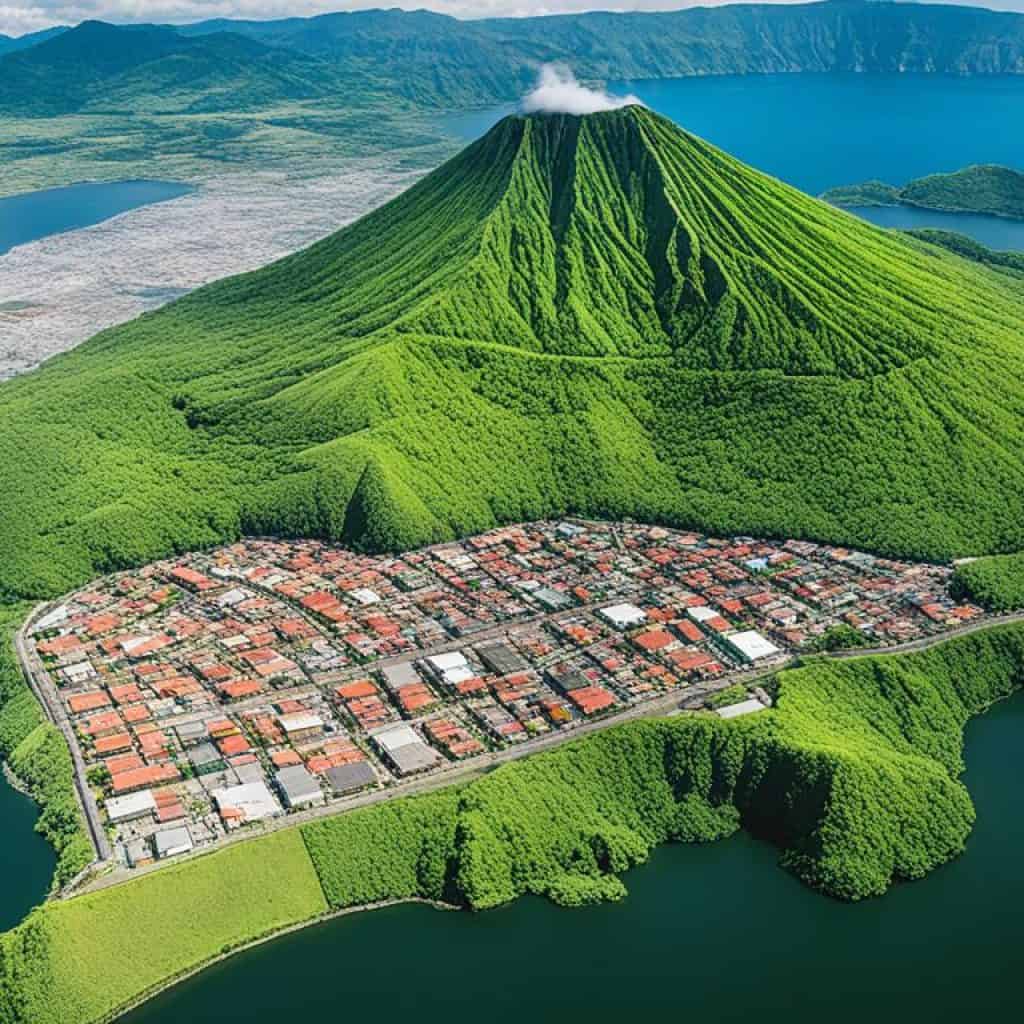
Taal Volcano’s Unique Landscape: Crater Lake and Volcanic Island
Taal Volcano is renowned for its awe-inspiring and distinct landscape, characterized by two prominent features – the Crater Lake and Volcano Island.
The Crater Lake, also known as the Main Crater Lake, is nestled within the enchanting Volcano Island. Remarkably, it is the largest lake on an island in a lake on an island worldwide. This mesmerizing lake was formed as a result of the massive 1911 eruption, which obliterated the previous crater floor, giving rise to this breathtaking natural wonder.
Volcano Island itself spans approximately 5 kilometers and is located within the Taal Lake’s magnificent caldera. Encompassing an area of around 23 square kilometers, this volcanic island is composed of overlapping cones and craters, boasting a total of 47 identified features. These distinctive land formations include tuff cones, cinder cones, and maars, forming a diverse and captivating landscape that adds to the allure of Taal Volcano.
Astounding Features of Taal Volcano’s Landscape
| Feature | Description |
|---|---|
| Crater Lake | The Main Crater Lake, the largest lake on an island in a lake on an island in the world, formed during the 1911 eruption. |
| Volcano Island | A 5-kilometer island located within the caldera of Taal Lake, composed of 47 identified features such as tuff cones, cinder cones, and maars. |
| Overlapping Cones and Craters | A unique feature of Volcano Island, exhibiting diverse land formations resulting from past eruptions. |
Taal Volcano’s Mystique and Historical Significance
One of the reasons that Taal Volcano has captured the fascination of researchers and historians is its unique mystique. Dr. Thomas Hargrove, a renowned expert on Taal, dedicated his work to unraveling the mysteries of this enigmatic volcano. In his book, “The Mysteries of Taal,” he delves into the eventful history of Taal Volcano, shedding light on its captivating past.
The impact of Taal Volcano’s eruptions extends far beyond its immediate vicinity. The towns surrounding Taal Lake have endured multiple relocations throughout history due to the volcanic activity. These eruptions have shaped the lives of the local communities, prompting migrations and relocations to safeguard against the dangers posed by the volcano’s unrest.
“The mysteries of Taal Volcano fascinate and bewilder us, reminding us of the power of nature and our constant struggle to coexist with its unpredictability.” – Dr. Thomas Hargrove
Impact on Human Settlements
Over the centuries, the eruptions of Taal Volcano have left an indelible mark on the towns surrounding Taal Lake. The frequent volcanic activity has disrupted settlements and forced residents to adapt to the ever-changing landscape. The resilience and perseverance of the communities in the face of such challenges highlight the historical significance of Taal Volcano as a catalyst for human adaptation and ingenuity.
Legacy of Taal Volcano
Throughout its tumultuous history, Taal Volcano has played a significant role in shaping the cultural heritage and historical narrative of the region. Its eruptions have shaped the physical landscape, causing the relocation of towns and the creation of new settlements. The enduring mystique and historical significance of Taal Volcano serve as a reminder of the human capacity to adapt and thrive in the face of adversity.
Taal Volcano’s Activity and Impact on Marine Life
Studies of the marine life in Taal Lake suggest that the body of water may have originated as a saltwater environment in prehistoric times. It is hypothesized that the entire area, including the provinces of Cavite and Batangas, was once part of a massive prehistoric volcano that collapsed into a caldera. This collapse resulted in the formation of Taal Lake, which accumulated freshwater from rainfall due to the closure of the channel connecting it to the sea.
The volcanic eruptions of Taal Volcano have had ecological implications for the lake’s marine life, shaping its composition and biodiversity. The discharge of volcanic materials and the accumulation of ash and sediment can alter the lake’s water chemistry and nutrient levels. These changes can affect the survival and reproduction of aquatic species, including fish, crustaceans, and plants, leading to shifts in the overall ecosystem equilibrium.
“The volcanic activity of Taal Volcano introduces a series of disruptions to the lake’s ecosystem, but it also provides opportunities for adaptation and evolution,” says Dr. Maria Santos, a marine biologist studying the impact of volcanic eruptions on aquatic life. “Some species may struggle to survive in the altered conditions, while others may thrive and fill the ecological niches left vacant.”
Research conducted after recent eruptions has shown that some species of fish have displayed adaptive behaviors, such as seeking refuge in deeper areas of the lake or migrating to other bodies of water. These responses demonstrate the resilience of marine life in the face of natural disturbances and offer valuable insights into the capacity of ecosystems to recover and adapt to changing environments.
Effects on Coral Reefs and Underwater Volcanic Activity
In addition to the impact on freshwater species, Taal Volcano’s eruptions can also affect nearby marine ecosystems, including coral reefs. Volcanic activity, such as the release of heat, gases, and ash, can cause thermal stress, reduced water quality, and increased turbidity. These conditions can harm sensitive organisms like corals, disrupting their growth and reproductive cycles.
Furthermore, underwater volcanic activity can create seamounts and hydrothermal vents, which serve as hotspots of biodiversity. These unique habitats provide refuge and resources for various marine species, contributing to the overall richness and diversity of the marine ecosystem.
| Ecological Impacts | Examples |
|---|---|
| Changes in water chemistry | Alteration of pH levels, nutrient availability, and oxygen content |
| Disruption of feeding patterns | Reduction in food availability due to ashfall and sedimentation |
| Loss of habitat | Destruction of underwater structures, such as coral reefs, seagrass beds, and mangroves |
| Shifts in species composition | Migration and colonization of new areas by opportunistic species |
Despite the disruptions caused by Taal Volcano’s eruptions, the marine ecosystem of Taal Lake has demonstrated a remarkable capacity for resilience and adaptation. Ongoing research and monitoring are crucial for understanding the long-term ecological impacts and implementing effective conservation measures to safeguard the biodiversity and sustainability of this unique aquatic environment.
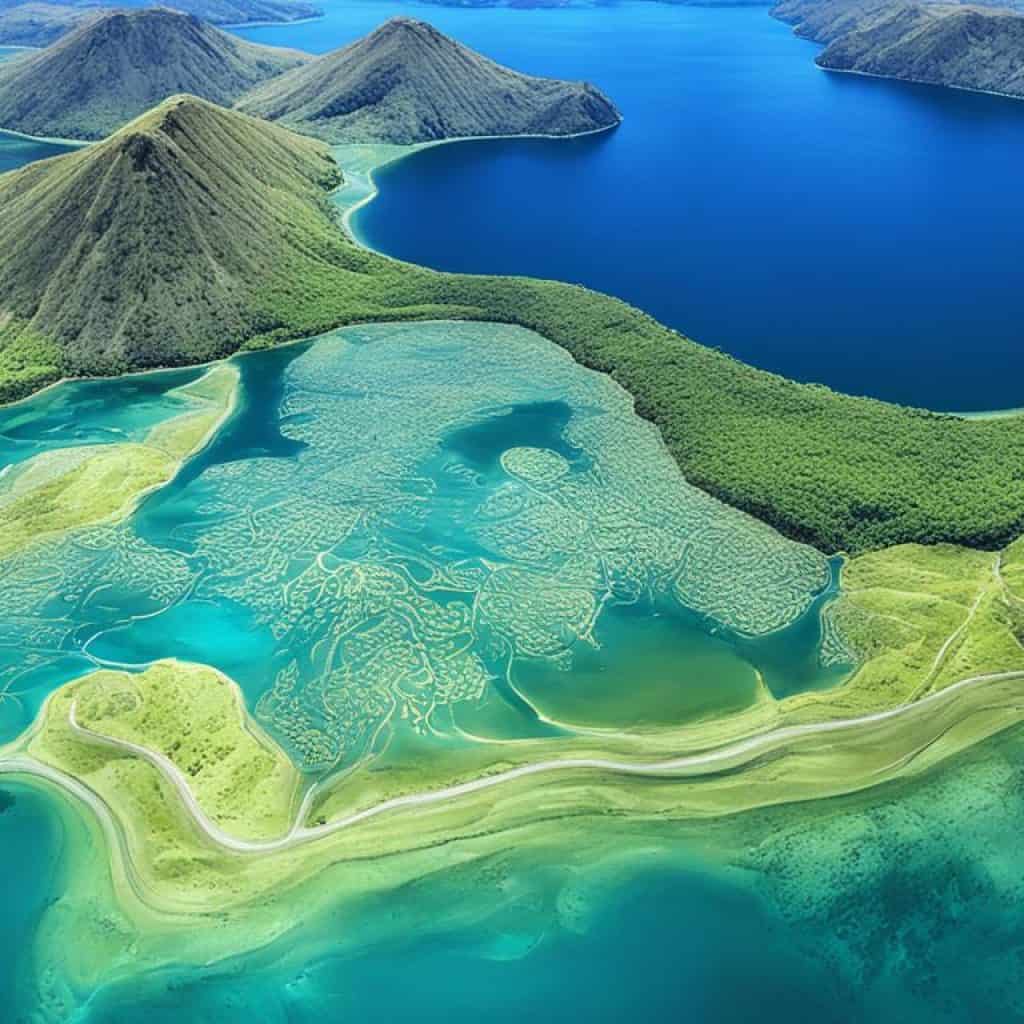
Current State and Recent Eruptions of Taal Volcano
The current state of Taal Volcano is a Level 3 alert, indicating magmatic unrest. A recent phreatomagmatic eruption, characterized by the eruption of magma and water, has prompted the authorities to raise the alert level. This eruption has triggered concerns over the safety of nearby communities, especially those in high-risk areas, such as Volcano Island and certain towns in Batangas.
The local authorities have swiftly implemented evacuation procedures to ensure the safety of residents. While the exact number of families that have evacuated is unknown, the measures taken are crucial in safeguarding the lives of children and families. Phreatomagmatic eruptions can result in a dangerous mixture of ash, rock, and volcanic gases, posing significant risks to the surrounding areas.
Evacuation Procedures and Local Authorities’ Response
In response to the eruption, local authorities have enacted evacuation procedures to protect those residing in high-risk zones. These procedures involve the systematic and efficient relocation of individuals and families to designated safe areas. By prioritizing the evacuation process, authorities aim to minimize the potential impact of volcanic hazards on the well-being of the affected communities.
The local government, in collaboration with relevant agencies and organizations, is actively coordinating efforts to ensure the smooth execution of evacuation procedures. This includes providing necessary resources and support to those displaced by the volcanic activity. Timely updates and communication channels have been established to keep residents informed about the situation and provide guidance on evacuation protocols.
“The safety and well-being of residents are our top priorities. We are working hand in hand with various agencies to ensure a swift and organized response to the current eruption of Taal Volcano,” said [local authority representative].
| Evacuation Procedures | Local Authorities’ Response |
|---|---|
|
|
The collective efforts of local authorities, organizations, and residents play a vital role in mitigating the potential risks associated with volcanic activity. By adhering to evacuation procedures and heeding the advice of local authorities, the well-being of children and families can be safeguarded.
Save the Children’s Response to Taal Volcano Eruption
Save the Children, as a global leader in child-focused humanitarian response, is closely monitoring the ongoing situation and stands ready to provide assistance in the event of further escalation. With a long history of responding to emergencies in the Philippines, including earthquakes, typhoons, and tsunamis, Save the Children has established itself as a trusted partner in delivering immediate relief to affected communities.
In the past, Save the Children has swiftly mobilized resources to provide urgent relief supplies to families impacted by disasters. These supplies include essential items such as food, clean water, hygiene kits, and shelter materials, ensuring that basic needs are met during times of crisis. The organization recognizes the importance of addressing the specific needs of children and their families, prioritizing their well-being and safety in every response effort.
Save the Children is also committed to ensuring that children have access to safe and productive learning spaces during emergencies. By setting up temporary schools and child-friendly spaces, the organization aims to restore a sense of normalcy and stability in the lives of children affected by the Taal Volcano eruption. Education and psychosocial support are crucial components of Save the Children’s humanitarian assistance, empowering children to cope with the emotional impact of disasters and continue their education despite the challenges they face.
Generous donations to the Children’s Emergency Fund enable Save the Children to deliver life-saving assistance to children and families impacted by crises. These funds are vital in providing immediate relief and facilitating long-term recovery efforts, ensuring that children’s needs are met and their rights are protected. By donating to Save the Children, individuals can make a tangible difference in the lives of those affected by the eruption of Taal Volcano, helping them rebuild and progress towards a brighter future.
Recent Response Efforts
“Save the Children has been on the ground since day one, responding to the urgent needs of children and families affected by the Taal Volcano eruption. Our teams have been working tirelessly to deliver critical aid and support to those who need it the most.”
| Date | Response Efforts |
|---|---|
| January 15, 2020 | Emergency distribution of food and clean water to affected communities. |
| January 18, 2020 | Establishment of temporary learning spaces and child-friendly spaces to provide psychosocial support and educational activities. |
| January 22, 2020 | Delivery of hygiene kits, including soap, towels, and other essential items, to ensure proper sanitation practices. |
| January 28, 2020 | Support for the construction of temporary shelters and provision of materials to families in need. |
Save the Children remains committed to its mission of ensuring the well-being and protection of children in times of crisis. Through its comprehensive and child-centered approach, the organization continues to make a positive impact on the lives of those affected by the eruption of Taal Volcano. By supporting Save the Children’s emergency response efforts through donations, individuals can contribute to the immediate and long-term recovery of communities, enabling children to thrive even in the face of adversity.
Support and Donations for Children and Families Affected by Taal Volcano
Do you want to make a difference in the lives of children and families affected by the eruption of Taal Volcano? You can contribute to the Children’s Emergency Fund to support the vital work of Save the Children. Your donations play a crucial role in providing immediate assistance during the early stages of an emergency, ensuring that the needs of children are prioritized and their lives are saved.
By donating to the Children’s Emergency Fund, you help fund essential relief supplies, education, and protection programs specifically designed for vulnerable children and families impacted by the eruption of Taal Volcano. This includes providing them with much-needed food, water, hygiene kits, and shelter materials to help them rebuild their lives.
When you make a 100% tax-deductible gift to the Children’s Emergency Fund, you make a significant impact on the lives of those affected by the crisis. Your generosity can pave the way for a brighter future, bringing hope and relief to those who need it the most.
Ways to Donate
There are various ways you can donate to the Children’s Emergency Fund:
- Online Donation: Visit our website at www.savethechildren.org to make a secure online donation.
- Text-to-Give: Text “EMERGENCY” to 20222 to make a $10 donation. Standard messaging rates apply.
- Phone Donation: Call our toll-free number at 1-800-123-4567 to make a donation over the phone.
- Mail-in Donation: Send a check or money order payable to Save the Children to:
| Recipient: | Save the Children |
|---|---|
| Address: | 123 Street Ave, City, State, ZIP |
| Memo: | Children’s Emergency Fund |
Your support and donations make a difference in the lives of children and families affected by the eruption of Taal Volcano. Together, we can provide the urgent assistance needed to save lives, protect children, and help rebuild communities in the aftermath of this natural disaster.
Impact of Your Donations
Your donations to the Children’s Emergency Fund have a significant impact on the lives of those affected by the eruption of Taal Volcano:
| Impact | Donation |
|---|---|
| Emergency Relief Supplies | $50 can provide a family with essential relief supplies, including food, clean water, and hygiene kits. |
| Education Support | $100 can provide a child with access to safe and productive learning spaces, ensuring they can continue their education amidst the crisis. |
| Protection Programs | $250 can support protection programs that help vulnerable children and families recover from the trauma of the volcanic eruption. |
Every dollar counts, and your donation can make a lasting impact on the lives of those affected by the eruption of Taal Volcano. Join us in providing hope, support, and a brighter future for children and families in need.
Conclusion
Taal Volcano, the smallest volcano in the Philippines, is a remarkable natural wonder that showcases the dynamic nature of our planet. Situated in the province of Batangas, this volcano has a history of frequent volcanic activity and historical eruptions, making it a subject of both geological and cultural significance. Its unique landscape, characterized by the mesmerizing crater lake and the volcanic island, is a testament to the awe-inspiring power of nature.
However, the potential hazards associated with Taal Volcano’s eruptions require constant monitoring and preparedness to ensure the safety of nearby communities. With its proximity to heavily populated areas, including Manila, it is crucial to have advanced systems in place to mitigate the impact of future volcanic events. Organizations like Save the Children play a vital role in responding to emergencies and providing support to children and families affected by natural disasters, including volcanic eruptions.
You can contribute to the ongoing relief efforts by donating to organizations like Save the Children, enabling them to provide immediate assistance to those in need. These donations help fund essential relief supplies, education programs, and protection initiatives for vulnerable children and families affected by the eruption of Taal Volcano. Together, we can make a positive impact and support the affected communities in their journey towards recovery.
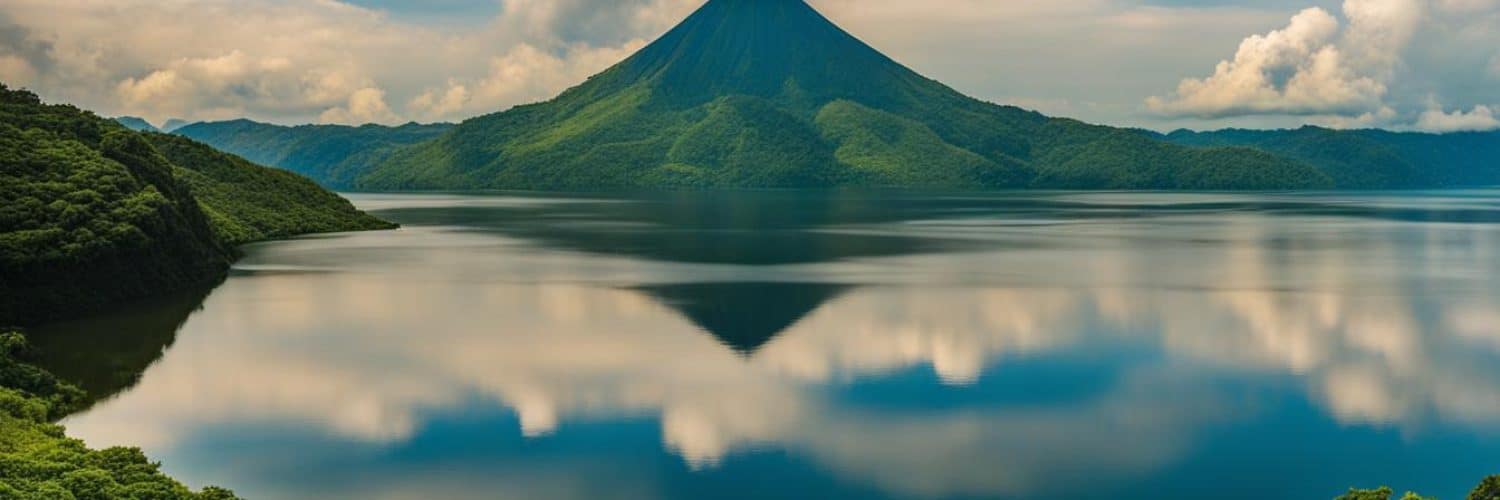

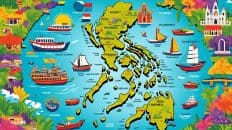











Add comment